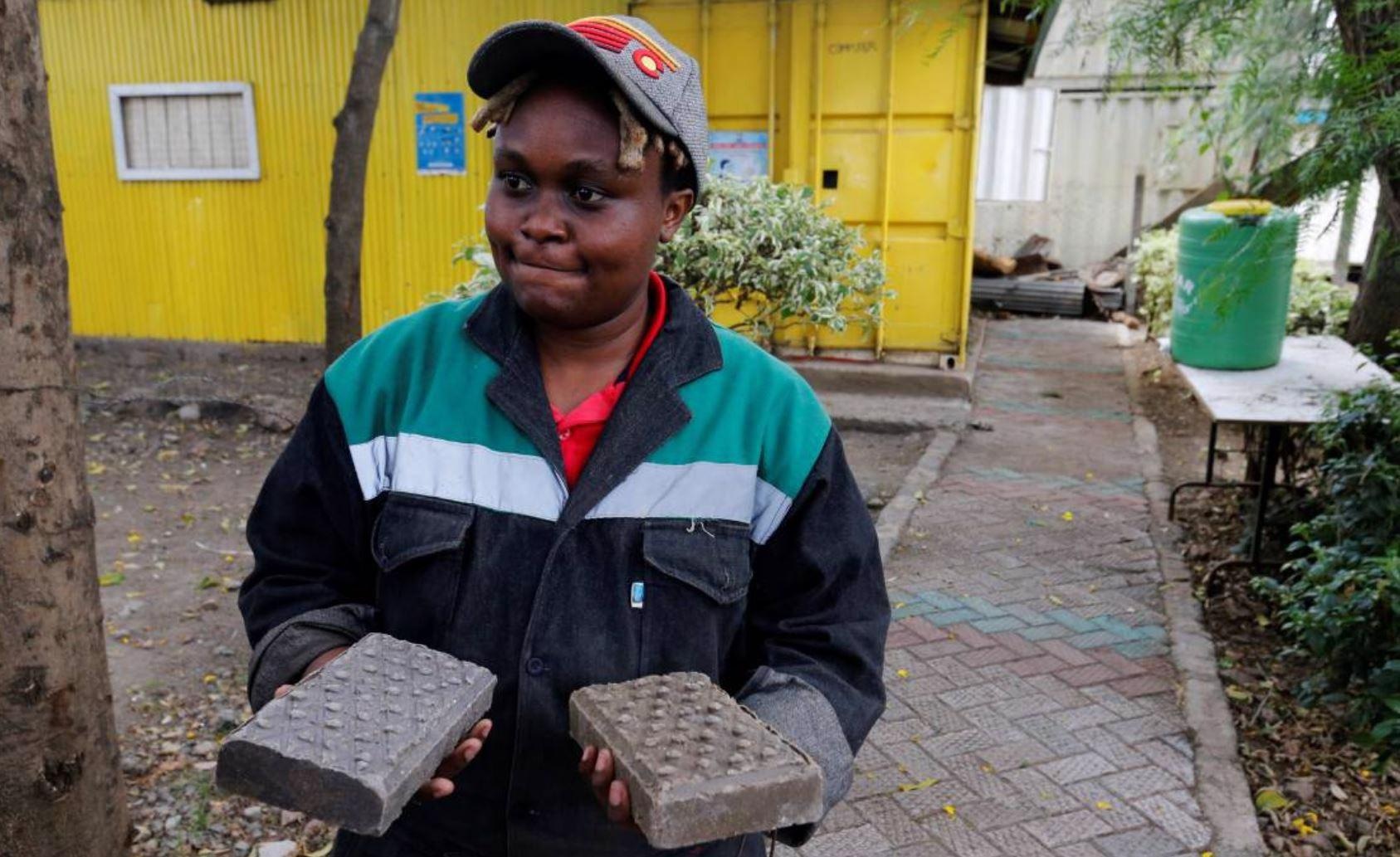 Nzambi Matee, founder of Gjenge Makers, pictured with paving bricks made from recycled plastic. Image Credit: REUTERS/Thomas Mukoya
Nzambi Matee, founder of Gjenge Makers, pictured with paving bricks made from recycled plastic. Image Credit: REUTERS/Thomas Mukoya
A Kenyan materials engineer sets a stunning example in the fight against plastic waste by using it to build tough, durable and lasting bricks.
The plastic crisis is one of the greatest global environmental threats currently facing mankind. As landfills and oceans alike fill with plastic waste and microplastics work their way into the food chain, Nzambi Matee has developed a strategy to potentially solve the problem of plastic pollution.
The Kenyan businesswoman and materials engineer who is the founder of Nairobi-based Gjenge Makers is turning plastic waste into strong and durable building materials.
Our product is almost five to seven times stronger than concrete. There is that waste they cannot process anymore; they cannot recycle. That is what we get.
Nzambi Matee, Founder, Gjenge Makers
As Matee describes her product’s viability as a building material, she provides a striking demonstration of her claim, hefting brick above her head and then casting it against a school footpath made from bricks containing recycled plastic. The brick strikes the footpath with a powerful thud but leaves no trace of damage to the bricks that comprise it.
Matee uses different kinds of plastics in her factory, producing one and a half thousand bricks a day. The factory processes both high and low-density polyethylene, the former mainly used in plastic bottles, the latter common in wrapping film and bags made to contain foodstuffs like cereal.
The factory also makes use of polypropylene — found in plastic containers like buckets, lids and caps. Matee currently doesn’t reprocess polyethylene terephthalate (PET).
Some of the plastic waste that Matee turns into building materials comes from packing factories for free and is mixed with other plastics and materials for which Matee pays.
Building on Waste Plastics
Plastics are strong, waterproof, lightweight, easy to mould, and recyclable, all of which are properties that we actively look for in building materials. And whilst their incredible durability is a major problem when they find themselves flooding into the environment, it's a boon for the building trade.
Many learning institutes are hot on the trial of effective ways of turning waste plastics into building materials, and this extends beyond bricks and tiles. Promising applications include the creation of concrete¹ and lightweight plasters and mortars².
One recent breakthrough was pioneered by Australian researchers who developed a ‘green brick’ that mixes plastics with waste plant fiber and a new type of rubber polymer³ — made from sulfur and canola oil.
Matee takes a slightly different approach to this, actually mixing waste plastics with sand. This mixture is then heated and compressed into the bricks that Matee sells for around 8 USD per square meter.
Tackling Plastic Pollution Means Coming off the Sidelines
Since setting up her factory in 2017, Matee has recycled 20 tonnes of plastic waste. A new larger production line is planned for the end of this year which could triple production.
Part of Matee’s drive to do something with plastic waste was born from the frustration of watching the government do little to tackle the problem of plastics pollution, and it is vital to remember that even large movements have small beginnings.
Matee concludes with a powerful message that we could all consider in regards to plastic pollution and other environmental issues, “I was tired of being on the sidelines.”
References
1. Kamaruddin. M. A., et al, [2017], IOP Conf. Ser.: Mater. Sci. Eng. 267 012011, [doi:10.1088/1757–899X/267/1/01201 1]
2. Corinaldesi. V., Donnini. J., Nardinocchi. A., [2015], ‘Lightweight plasters containing plastic waste for sustainable and energy-efficient building,’ Construction and Building Materials, [https://doi.org/10.1016/j.conbuildmat.2015.07.069]
3. Lundquist. N., Tikoalu. A., Worthington. M., et al, [2020], Chemistry-A European Journal, [https://doi.org/10.1002/chem.202001841]
4. Hama. S. M., Hilal. N. N., [2017], ‘Fresh properties of self-compacting concrete with plastic waste as partial replacement of sand,’ International Journal of Sustainable Built Environment, [https://doi.org/10.1016/j.ijsbe.2017.01.001]
5. Plastic Oceans, [https://plasticoceans.org/the-facts/]
Disclaimer: The views expressed here are those of the author expressed in their private capacity and do not necessarily represent the views of AZoM.com Limited T/A AZoNetwork the owner and operator of this website. This disclaimer forms part of the Terms and conditions of use of this website.